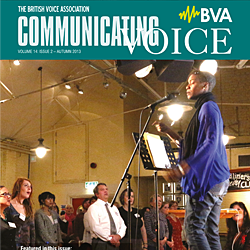About the Association
Archived newsletter articles
Choice for Voice
10 – 12 July 2008
Day 1
British Voice Association event report – by Jeffrey Davies
As emphasised in the warm welcome given by BVA president Linda Hutchison and conference chair Janice Chapman, "in true BVA style", the programme is multidisciplinary, ranging across aspects of performance, health and research, and it goes without saying, teaching. For the first day, which related mainly to singing, I was interested in interactions between disciplines and chose workshops on singing as viewed by speech and language therapists, researchers, a psychologist, and a vocal coach.
How appropriate to begin the day with Ron Morris (left), speech therapist and audiologist who is also a singer, giving the plenary lecture "My tongue goes where (and does it matter)?" He guided us entertainingly through the anatomy of the intrinsic and extrinsic muscles and their interactions. Misuse of tongue blade or tip, or tongue root constriction are among problems in speech and singing which must be corrected. Some thought-provoking points were made. The IPA system (relating to tongue positions) works well for teaching consonants; but "vowel quadrilation is rubbish". Vowels have acoustic cues and vocal tract shape is important. For classical singers, the tongue needs to be high towards the back, the tongue root free, and the larynx allowed to drop. If the tongue is low, it pulls the soft palate down. Likewise the jaw should be loose, but good articulation and vocal quality require little mouth opening. Ron answered his subsidiary title question "does it matter", with an emphatic "yes, yes, yes!" In his workshop, he demonstrated tongue exercises for remediation of speech and for free, well-articulated singing. These included poking out the tongue, stretching and holding out the tip, raising and lowering the tip, and syllables for tip-blade or front-back alternations. A hand-out of exercises was provided and also a seven page diagnostic "Articulation efficiency assessment for singers". Many attendees at this will be keen to practice and learn more.
Speech therapist Hugo Lycke’s workshop (right) on "Voice classification by phonetography" was a preliminary study involving measuring vocal sound intensity extremes over a range of sung pitches. The maximum and minimum intensities in the range overlaps vary for different voice types and contribute to their classification. What is the importance of this compared to tessitura and passagio? Other technologies and further investigation are needed. Gillian Kayes (singing teacher and researcher) and Sarah Harris (speech and language therapist) presented a clinically-based paper on "Can vocal gesture "pictograms" be used to help identify vocal behaviours in singers of different genres? Do gestures (laryngeal areas as revealed by nasoendoscopy) change over range? How do singers of different genres compare? What factors influence gestures? Classical and musical theatre singers of similar voice types were given song and scale tasks. The observation area extended from the arytenoids and hyoepiglottic ligament, to the posterior pharyngeal wall. Genres were validated by seven judges. Clearly qualitative comparative data are obtainable for different singing styles, and perhaps a norm for these can be established enabling quantification by area measurements. Katrin Neumann presented "Attractiveness of the high singing voice", a pilot study from a psychologist’s angle. Speech can suggest personality, behaviour, age or size. A low male voice (high testosterone?) can suggest status and dominance, masculinity. A high pitched voice (low testosterone?) might imply a more paternal character, more suited to a long term relationship. Why in opera are tenors romantic heroes and male pop singers engaging a high falsetto so popular? Thirty two females (and thirteen males) were asked to rate recordings of various singers on personal or behavioural parameters. The results were not conclusive.
Speech and language therapist Rosemarie Morgan-Watson contributed "How can I express who I am when I can’t tell you", a reflection of personal experience, incorporating some aspects of Feldenkrais teaching. Her journey moved from loss of voice through recovery, "renewing the inner and outer voice" and relating to an awareness of the physicality of body and movement. "As long as we may be able - to hear who we are - this may inspire others recover their true potential". Stuart Barr (vocal coach and music director) gave a workshop on "Directing the naked voice: how emotional content changes the singing voice". He demonstrated with an actress singing in musical theatre style, eschewing a technical approach. He probed for the character, thoughts, emotions and situation. "Who is she?", "What has happened?", "How does she feel about that?", "Where is she?". The singer improved with each idea, building a believable performance with more expressive vocal colours. Interestingly, her register change was less noticeable. "Find how the body accesses what is needed naturally".
The Artistry in Action was indeed that, with Guildhall students from years 1 to 3, plus the advanced opera year, singing songs, opera and oratorio arias. A delightful and yet informative way to end the day. Linnhe Robertson led the session, joined by Janice Chapman, Penelope MacKay, and Rudolf Pierney. There was discussion about repertoire for young voices which led to agreement as to the importance of always singing "within the comfort and quality zones". Concerning the length of training (differing for individuals), a minimum of "at least five years" and "seven years, eight for opera" were suggested. In practice, this might relate to tuition hours provided, and hence funding.
I was hoping to find stimulating cross-talk between disciplines, practitioner-driven research, and new thoughts on familiar concepts and problems. I was not in the least disappointed, but rather enthused to experience and discover more. If only it were possible to attend all choices of sessions.
Day 2
British Voice Association event report – by Liza Hobbs
I am a singing teacher/performer and came to the BVA conference as a new member and brim with curiosity. There were moments when I felt like a spoilt child with an over-full toy box, and in danger of losing my selective powers. There were others when I got a bit frustrated and cross, but more on that later. The overall sensation was one of enjoyment, and admiration for the unsung heroes who do all the back-room work that usually goes unnoticed (...until something goes wrong, that is).
Choice was the order of the day, and I made several good ones, some not so good, and not always for the expected reasons. Sometimes I felt faced with deciding between three or more alternatives none of which fired me, - and came away inspired! One choice was made on the grounds that I had just met the person taking the class and liked the way she talked about her work – that one was a good one. Another was made on the grounds that it was a medical problem that I kept coming up against in my work – and that was a bad one for the simple reason that the spoken delivery was appalling, the use of Power Point (which is surely meant to enhance a presentation?) was distracting, unhelpful and using such small print that it was barely readable from the 3rd row. In one sense the most inspiring insight came from (for me) an unexpected quarter. M Seipelt (below right) and his team from Frankfurt reported on a Wagnerian singer who had been injured by a blow to the neck in Karate which caused not only the expected pain but also a considerable loss of range and volume in his voice.
On thorough examination he and his ENT team could find nothing that might be causing this, and so handed him over to colleagues who eventually treated the singer to almost complete recovery through manual therapy of almost the entire body and not simply the immediate area of the injury. I thought this a shining example of interdisciplinary co-operation and mutual respect, and a beautiful metaphor for what the British Voice Association seems so good at doing.
So, what were the highlights for me? Peaceful moments in Sheila Gordon’s interesting workshop on The Tactile Voice; very nearly, at long last, getting to grips with exactly what the "singer’s formant" is in Ron Scherer’s excellently clear Plenary Workshop (I’ll get there one day), watching Lynne Wayman’s class trying to impersonate an audience at a rock concert in an effort to make her rock singer feel at home (he succeeded better than we deserved!), rock singer getting to grips with tongue! and the glorious sung contributions from the young people on the Royal Academy of Music Post Graduate Musical Theatre course which brought the day to such an enjoyable ending.
And, as a final comment, despite the fact that the conference was somehow wedged into the spaces allotted by an apparently already busy Guildhall/Barbican, in a building complex in which it is famously easy to get lost, we were at all times expertly directed and beautifully looked after.
Day 3
British Voice Association event report – Joanne Zorian-Lynn
With something for every discipline this packed day, focussing predominately on voice for speech, began with a lecture from Ron Scherer, Professor of Communication Disorders, Bowling Green State University, USA (below left). His impressive research, including the construction of a Plexiglas model, analysed air pressure and air flow through convergent-shaped, uniform-shaped and divergent-shaped vocal folds.
Directly after coffee a variety of workshops were on offer. Ron Morris, Speech Therapist, Audiologist and Counter Tenor with a Brisbane choir guided us through visual observation to identify compensatory articulation deficiency. His presentation, delivered with humour and personality, called on our participation in valuable tongue-tip exercises.
In an introduction to Brain Gym with singing coach Teresa Goble, we practised physical exercises to stimulate cross-brain activity. The objective is to provide an alternative method to access whole brain learning, increase creativity and relieve stress. She suggested that these physical exercises would open up energy channels and assist in opening the lower back and releasing breath. This seminar proved to be quite controversial when delegates asked for scientific evidence and base-line measures, which were not provided, rather than anecdotal evidence. A debate, which I feel will continue.
Lunch break gave us the opportunity for more lively networking and exchange of thoughts and experiences. An added energy to the environment was introduced as Guildhall students and audience gathered in the foyer for the matinee of their graduation show. However, Choice for Voice had plenty of activities for the afternoon and we were ‘spoilt for choice’ in selecting the next sessions to attend.
Julia Moody, from the Western Australia Academy of Performing Arts, invited us on a tour of accents. Noting that her students are influenced by television and unknowingly imitating American accents, she has found that by playing with accents and dialects, students can have fun whilst comfortably exploring how sound is made and speech is varied. We enjoyed showing off our newly acquired Aussie accents!
Laryngologist Julian McGlashan from Nottingham University asked, ‘Can vocal effects such as Distortion, Grunting and Growling be produced without damaging the vocal folds?’ These are sounds, unconnected to melody or text, which characterise a singer’s style or convey an emotion. Close examination showed where and how in the vocal tract the support and assistance to such sound production can be made safely.
The need for more vocal coaching in student teacher training was clearly identified by the paper delivered by Pauline Sloane. Her research showed a direct correlation between anxiety and voice problems and occupational efficiency.
Speech language pathologist Marina Gilman gave us hands-on instruction in floating the Hyoid and, thus, freeing the voice.
To round off the day Artistry in Action was led by vocal coach Victoria Newlyn accompanied by four students. We observed the impact of a speech vocal warm up and exercises connected to text and differing thought processes upon the performance.
I would loved to have attended more seminars and papers however the feedback at break-times from those I missed was all extremely positive.
The genuine appreciation for the hard work of the all those who put this course together cannot be underestimated. The event was run like a well-oiled machine and not only were there great learnings but friendships re-kindled and new ones made.
Conference Overview
British Voice Association event report – by Emily Romney, Voice Faculty, Longy School of Music, Cambridge, Massachusetts, USA
The British Voice Association’s conference in July brought each of us together with other voice and singing teachers, performers, students, voice science researchers, and medical practitioners from across the world for a stimulating, briskly paced three day immersion into the world of voice. What made Choice for Voice a special experience for me?
The schedule was designed so that each day researchers, clinicians, and voice teachers shared their experiences and expertise through lectures, workshops, and performance. Whether one came for one day or three, one felt the inter-disciplinary BVA spirit and philosophy in action. No one could attend every event, but the cross-currents of disciplines were available to everyone in the plenary lectures and workshops.
The overall quality of presentations I attended was excellent. I appreciated hearing about new work being done in voice science and voice medicine and methods of research and evaluating results in these fields. More relevant to my work as a singing teacher were opportunities to learn about and, in a few instances to try out techniques being used by voice professionals in greater and smaller arenas. Occasional opportunities to participate actively were invaluable.
The Venue was supportive: Holding the conference in the GSMD and the Barbican, meant that we spent most of each day – not in dead and deadly hotel meeting rooms, but in acoustically friendly spaces, most that had been designed for unamplified conversation and/or voice performance. Obligatory treks through the GSMD (still alive with in-term activity) and the Barbican from lecture hall to tea break to workshop rooms were welcome scheduled opportunities to move and stretch between periods of sitting.
Providing lunch each day was an hospitable solution to the problem of finding sustenance. Lunchtime brought people together rather than scattering them and made this time of the day valuable for making professional contacts, and sharing information, gossip, opinions, ideas as well as lunch.
Artistry in Action showcasing the work in progress of advanced conservatory students kept in mind the glories that can emerge with the expert support represented during the day’s sessions.
The Concert of songs and scenes from opera and musical theatre beautifully conceived and charmingly performed by Linnhe Robertson and GSDM students on the first evening of the conference was outstanding.
It was a rare opportunity to hear the plenary speakers, representing three major strands of the BVA fabric: voice science, voice therapy, and voice medicine. I hope for the next Choices for Voice conference there will be among the plenary sessions or plenary workshops, teaching demonstrations of voice and singing involving technical work and musical or dramatic coaching. While such demonstrations were not totally absent, giving this activity center stage would acknowledge that the studio is the arena where ideally, research and therapy and pedagogy come together, the laboratory in which the long process toward the wonderful artistic performances we heard unfolds.
Many thanks to the staff of the BVA and all the conference planners and producers for an experience well worth a trip ‘across the pond’.
More archived content online
Disclaimer
Neither the British Voice Association nor the Editor can be held responsible for errors or any consequences arising from the use of information contained in its newsletters (or extracts from its newsletters published online); the views and opinions expressed do not necessarily reflect those of the British Voice Association (BVA) or the Editor, neither does the publication of advertisements constitute any endorsement by the BVA or Editor of any products or services featured.

 Join us Now!
Join us Now! our newsletter
our newsletter free voice care leaflets & information – download here
free voice care leaflets & information – download here Help our work by donating while you shop
Help our work by donating while you shop